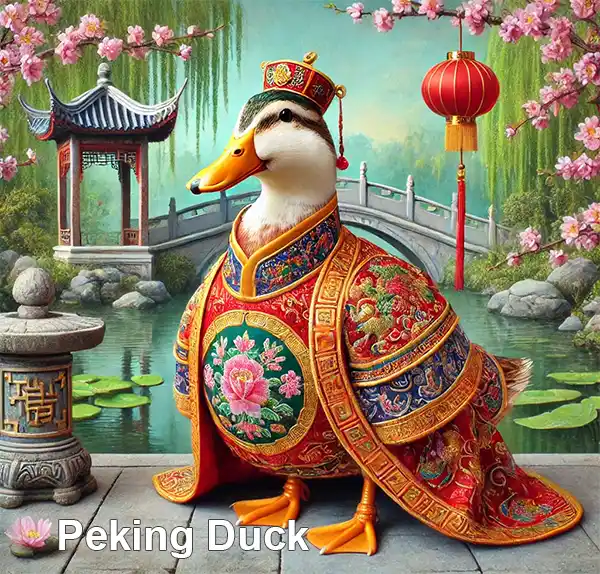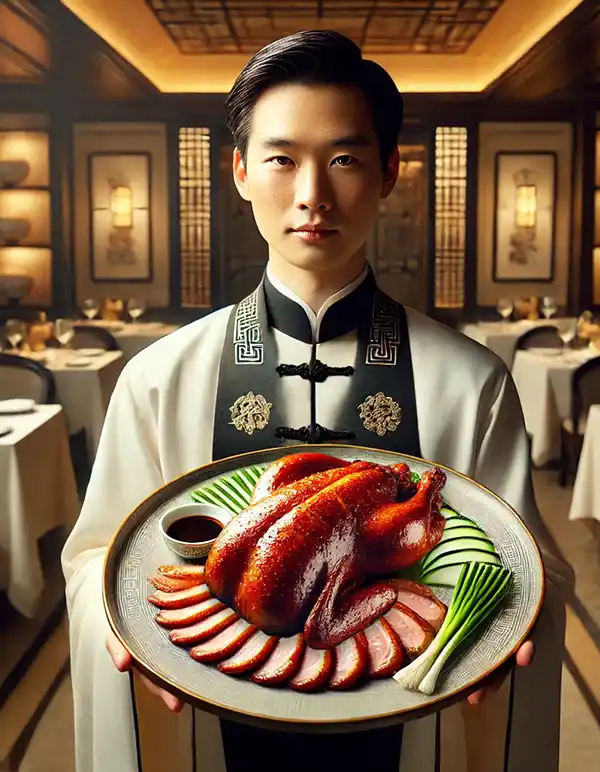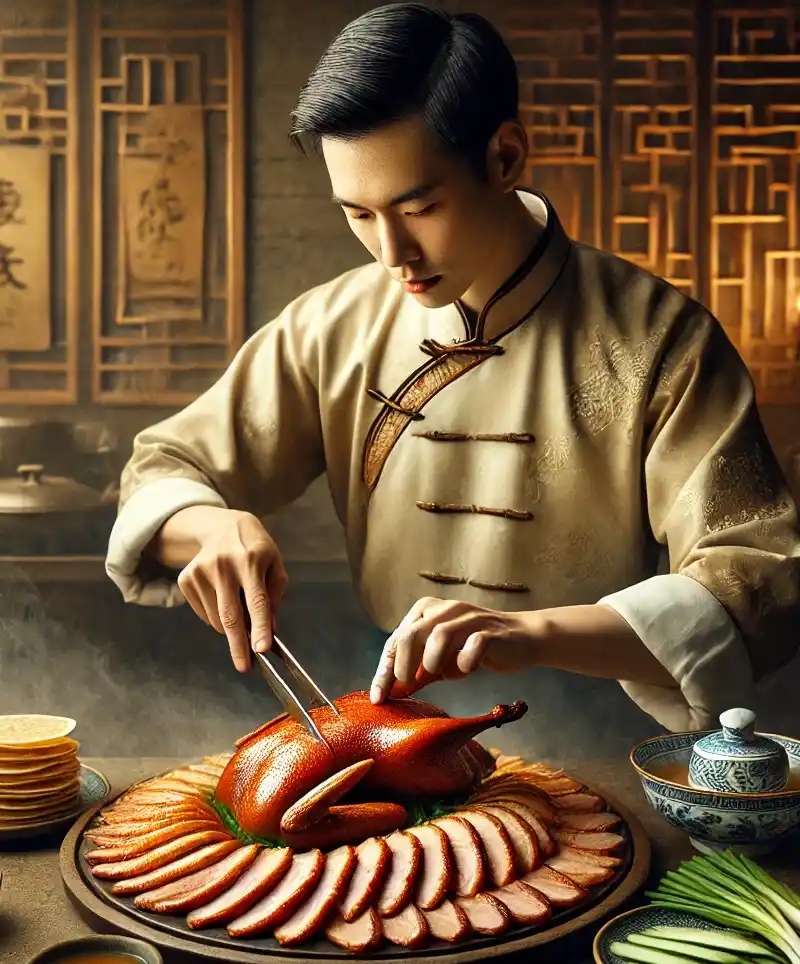 A Culinary Celebration of Crispy Perfection
A Culinary Celebration of Crispy Perfection
January 18th marks National Peking Duck Day, a glorious occasion dedicated to one of the world’s most celebrated dishes. Whether you’re a seasoned Peking Duck aficionado or someone who’s just here for the crispy skin, today is the perfect day to explore the rich history, meticulous preparation, and cultural significance of this iconic Chinese delicacy.
The Origins of Peking Duck: From Imperial Kitchens to Global Fame
Peking Duck dates back over 600 years to the Yuan Dynasty, when it was initially a dish reserved for Chinese royalty. The Ming Dynasty elevated it further, with chefs perfecting the intricate cooking techniques still used today. Historical records show that the dish was a favorite of emperors, who would request it as part of elaborate feasts. The dish eventually became synonymous with Beijing (formerly known as Peking), earning its name and cementing its place as a culinary treasure.
What makes Peking Duck truly unique is the culinary artistry behind its creation. The process involves more than just cooking—it is a dance of science, tradition, and ingenuity. By inflating the duck to separate the skin from the meat, chefs ensure that the skin crisps up during roasting, creating the dish’s signature texture. The duck is then air-dried and coated with a glaze that caramelizes during roasting, adding a subtle sweetness to its flavor profile.
During the Qing Dynasty, the popularity of Peking Duck spread beyond the imperial court, with aristocrats and commoners alike developing a taste for the dish. By the late 19th century, specialized restaurants like Bianyifang and Quanjude had opened their doors, perfecting the art of Peking Duck and making it accessible to the public. Today, these establishments remain iconic culinary landmarks, drawing food lovers from around the world.
The duck’s allure lies not only in its taste but also in its role as a symbol of Chinese hospitality and culture. Whether served at family gatherings, weddings, or state banquets, Peking Duck represents a rich culinary heritage that continues to bring people together.The duck’s allure lies in its crispy, amber-hued skin, achieved through a meticulous process that involves inflating the duck to separate the skin from the meat, then air-drying it and roasting it to perfection. This isn’t just food; it’s an edible work of art.
The Preparation: A Labor of Love
If you think making Peking Duck is as simple as popping a bird in the oven, think again. The preparation process is so elaborate it could double as an Olympic event in precision and patience:
- Selecting the Duck: Not just any bird will do. Traditionally, a specific breed of duck raised in Beijing was used, prized for its tender meat and optimal fat-to-skin ratio.
- Inflation Station: The duck’s skin is carefully separated from the meat by inflating it with air—a process that’s both fascinating and slightly bizarre.
- Seasoning and Drying: The duck is seasoned with a mix of spices and then air-dried for hours (or even overnight) to ensure the skin crisps up beautifully.
- Roasting: Traditionally cooked in a cylindrical wood-fired oven, the duck is roasted to achieve that signature golden-brown sheen and unparalleled crunch.
The result? A dish so delectable that even the most disciplined among us will find ourselves shamelessly devouring it, skin first.
 A Delicious Ritual
A Delicious Ritual
Eating Peking Duck is an experience as much as a meal. The traditional method involves three main components:
- The Skin: The pièce de résistance. Often served with a sprinkle of sugar for an extra touch of decadence.
- The Pancakes: Thin, soft, and slightly chewy, these wrappers are the perfect vessel for the duck.
- The Accompaniments: Sliced scallions, cucumber, and hoisin sauce round out the flavors, creating a symphony of sweet, savory, and crunchy.
To assemble, you take a pancake, add a slice of duck (preferably with skin), drizzle on some hoisin sauce, and top it with the veggies. Roll it up like a mini burrito, and voilà: heaven in every bite.
Peking Duck Around the World
While Beijing remains the spiritual home of Peking Duck, the dish has gained fans across the globe. From five-star restaurants to humble takeout joints, you can find variations that pay homage to the original while incorporating regional twists.
In the United States, chefs often experiment with local ingredients and cooking methods, but purists know that nothing beats the authentic version served at centuries-old establishments in Beijing, such as Quanjude or Bianyifang.
Fun Facts About Peking Duck
Peking Duck isn't just a culinary masterpiece; it's also a dish with a treasure trove of fascinating tidbits. From its ancient origins to its modern-day quirks, these fun facts showcase why this dish has earned its iconic status in the world of gastronomy. Prepare to be amazed, amused, and perhaps a little hungry!
- The oldest Peking Duck restaurant in Beijing, Bianyifang, was established in 1416—making it older than the United States.
- Some high-end restaurants require you to order Peking Duck 24 hours in advance due to the intricate preparation process.
- Traditionally, the chef carves the duck tableside, a performance that’s almost as satisfying as eating the dish itself.
- A single Peking Duck can yield up to 120 slices, ensuring every guest gets their share of crispy, succulent goodness.
How to Celebrate National Peking Duck Day
National Peking Duck Day is more than just an excuse to eat; it’s a chance to dive into the rich cultural and culinary heritage of this legendary dish. Whether you’re dining out, trying your hand at cooking, or simply learning about its history, there are countless ways to make the day memorable. Here’s how you can join the celebration:
- Visit a Restaurant: Treat yourself to Peking Duck at an authentic Chinese restaurant. If you’re lucky, you might even witness the dramatic carving process.
- Cook at Home (If You Dare): Feeling adventurous? Try making Peking Duck from scratch. Warning: patience and a good sense of humor required.
- Learn the History: Dive into the fascinating background of this dish, from its royal roots to its modern-day global appeal.
- Share the Love: Post your Peking Duck feast on social media using #NationalPekingDuckDay and make your friends drool.
Why Peking Duck is More Than Just a Meal
Peking Duck isn’t merely a dish; it’s a testament to the artistry and dedication of Chinese culinary traditions. Its rich flavors, intricate preparation, and storied history make it a meal that transcends borders and generations.
So, on this National Peking Duck Day, grab your chopsticks, savor every bite, and toast to the chefs who’ve spent centuries perfecting this crispy masterpiece. Here’s to a dish that proves that sometimes, the duck really does deserve all the glory.
Please Share our Content






 A Culinary Celebration of Crispy Perfection
A Culinary Celebration of Crispy Perfection A Delicious Ritual
A Delicious Ritual








 "Sláinte!" is a traditional Irish expression used as a toast, equivalent to "Cheers!" in English.
"Sláinte!" is a traditional Irish expression used as a toast, equivalent to "Cheers!" in English.